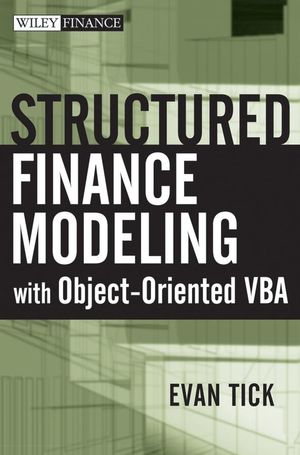Structured Finance Modeling with Object-Oriented VBAISBN: 978-0-470-09859-2
Hardcover
352 pages
May 2007
 |
||||||
List of Acronyms.
Acknowledgments.
About the Author.
Chapter 1. Cash-Flow Structures.
1.1 Getting Started.
1.2 Securitization.
1.3 Synthetic Structures.
1.4 Putting It All Together.
Chapter 2. Modeling.
2.1 Dipping a Toe in the Shallow End.
2.2 Swimming Toward the Deep End.
2.3 Types.
2.4 Class Architecture.
2.4.1 Weak Inheritance.
2.4.2 Parameterized Class.
2.4.3 Which Is Better?
2.5 Exercises.
Chapter 3. Assets.
3.1 Replines.
3.2 Portfolio Optimization.
3.2.1 Zero-One Program.
3.2.2 Simulated Annealing.
3.3 Losses, Prepayments, and Interest Rates.
3.4 Cash-Flow Model.
3.4.1 Zero-Prepay Cash Flows.
3.4.2 Actual Cash Flows.
3.4.3 Examples.
3.5 S&P Cash-Flow Model.
3.5.1 Model Parameters.
3.6 Moody’s Cash-Flow Model.
3.6.1 Model Parameters.
3.6.2 Algorithm.
3.7 Option ARMs.
3.8 Class Architecture: Multiple Inheritance.
3.9 Doing It in Excel: SumProduct.
3.10 Exercises.
Chapter 4. Liabilities.
4.1 Getting Started.
4.2 Notation.
4.3 Expenses.
4.4 Interest.
4.5 Over-collateralization.
4.5.1 Current Subordinated Amount.
4.5.2 Stepdown Date.
4.5.3 Target Subordinated Amount.
4.6 Principal.
4.6.1 Gross Principal Distributions.
4.6.2 Detailed Principal Distributions.
4.7 Writedowns and Recoveries.
4.8 Derivatives.
4.8.1 Corridors.
4.8.2 Swaps.
4.8.3 Excess Reserve Fund Account.
4.9 Triggers.
4.9.1 Call Features.
4.9.2 Overcollateralization Test.
4.9.3 Interest Coverage Test.
4.9.4 Delinquency Trigger.
4.9.5 Loss Trigger.
4.10 Residuals: NIMs and Post-NIM.
4.11 Class Architecture.
4.11.1 Passive Approach.
4.11.2 Active Approach.
4.11.3 Comparison.
4.12 Doing It in Excel: Data Tables.
4.13 Exercises.
Chapter 5. Sizing the Structure.
5.1 Senior Sizing.
5.2 Subordinate Sizing.
5.2.1 Fully Funded vs. Non–Fully Funded.
5.3 Optimizations and Complexity.
5.4 Example of Sizing.
5.5 NIM and OTE Sizing.
5.6 Class Architecture.
5.6.1 Inheritance Revisited.
5.6.2 Odds and Ends.
5.7 Doing It in Excel: Solver.
5.8 Exercises.
Chapter 6. Analysis.
6.1 Risk Factors.
6.1.1 Prefunding.
6.1.2 Prepayments.
6.1.3 Buybacks and Cleanup Calls.
6.1.4 Defaults.
6.1.5 Interest Rates.
6.1.6 Spreads.
6.1.7 Miscellaneous.
6.1.8 Residual Sensitivities.
6.2 Mezzanine and Subordinate Classes.
6.3 NIM Classes.
6.4 Putting It All Together.
6.5 Exercises.
Chapter 7. Stochastic Models.
7.1 Static versus Stochastic.
7.2 Loss Model.
7.2.1 Probability of Default from Transition Matrix.
7.2.2 Probability of Default from Spread.
7.2.3 Probability of Time to Default.
7.3 Gaussian Copula.
7.4 Monte Carlo Simulation.
7.5 Synthetic Credit Indexes.
7.5.1 Loss Lets.
7.5.2 Analysis.
7.5.3 Hedging.
7.6 Doing It in Excel.
7.7 Exercises.
Appendix A. Excel and VBA.
A.1 Spreadsheet Style.
A.2 Code Style.
A.3 Compilation.
A.4 Bloomberg.
Appendix B. Bond Math.
B.1 Mortgage Payment.
B.2 Yield to Price.
B.3 Price to Yield.
B.4 Duration.
B.4.1 Index or Interest-Rate Duration.
B.4.2 Discount Spread Duration.
B.5 Hazard Rate.
B.6 Static Credit Card Model.
References.
Index.



